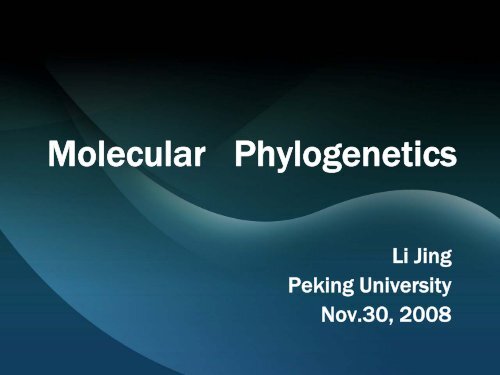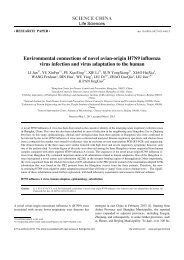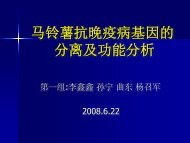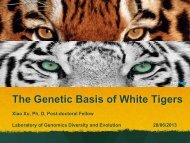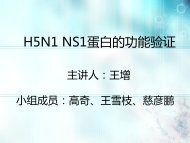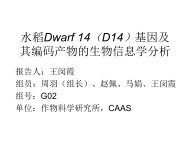2 - abc
2 - abc
2 - abc
- No tags were found...
You also want an ePaper? Increase the reach of your titles
YUMPU automatically turns print PDFs into web optimized ePapers that Google loves.
Molecular Phylogenetics<br />
Li Jing<br />
Peking University<br />
Nov.30, 2008
Contents<br />
1 Phylogenetics Introduction<br />
2 Tree Construction<br />
3 Programs & Examples
Introduction<br />
Phylogenetics:<br />
The study of the evolutionary history of living organisms.<br />
Two major assumptions:<br />
1. Molecular sequences used in phylogenetics<br />
construction are homologous.<br />
2. Each position in a sequence evolved independently.
Classification:<br />
study on “products” of<br />
evolution<br />
Evolution:<br />
Studies on “processes”,<br />
and forces driving<br />
processes<br />
Phylogeny:<br />
Studies on<br />
“relationship” of taxa<br />
and evolutionary<br />
events<br />
Tree<br />
Modified from Stuessy, 1990. Plant taxonomy, p.8. Columbia UP, NY.
Study of phylogeny<br />
A phylogeny is a reconstruction of the evolutionary<br />
history of a collection of organisms.<br />
• A phylogeny is a type of pedigree.<br />
• Showing relationships between taxa (ex.<br />
species), not individuals.<br />
• Reconstructs pattern of events leading to<br />
the distribution and diversity of life<br />
• Often shown as a network or tree
Introduction<br />
D A B C E<br />
Newick format<br />
= ((d,a),(b,(c,e))) or ((b,(e,c),(a,d))
Introduction<br />
Terminal nodes<br />
(leaves; OTUs)<br />
Pan<br />
Homo<br />
Gorilla<br />
Pongo<br />
terminal branches<br />
internal branch<br />
internal node<br />
an<br />
the root
Monophyly & Polyphyly<br />
polyphyletic group<br />
monophyletic group<br />
common ancestor
Sister group & Outgroup<br />
Sister groups<br />
Outgroup of (B, C)<br />
ingroup<br />
Non-sister groups
Rooted & Unrooted Trees<br />
类 群 数 为 m<br />
有 根 二 歧 树 :<br />
无 根 树 :<br />
[(2m-3)!]/[2 m-2 (m-2)!] (m>=2)<br />
用 m-1 代 替 上 式 中 的 m。
Polytomy & Dichotomy<br />
un-resolved relationships<br />
polytomy<br />
partially resolved relationships<br />
dichotomy<br />
fully resolved relationships<br />
Polytomy: an internal node<br />
with more than 2 immediate<br />
descendants<br />
“hard” polytomy:<br />
simultaneous divergence<br />
“soft” polytomy: unsure<br />
order of divergence<br />
Binary<br />
bifurcating tree
Cladograms & Phylograms<br />
Relative<br />
Time<br />
Absolute<br />
Time or<br />
Divergence<br />
Bacterium 1<br />
Bacterium 2<br />
Bacterium 3<br />
Eukaryote 1<br />
Eukaryote 2<br />
Eukaryote 3<br />
Eukaryote 4<br />
Cladograms:<br />
branching order<br />
Phylograms:<br />
Bacterium 1<br />
Bacterium 2<br />
Bacterium 3<br />
Eukaryote 1<br />
Eukaryote 2<br />
Eukaryote 3<br />
Eukaryote 4<br />
order & lengths
Contents<br />
1 Phylogenetics Introduction<br />
2 Tree Construction<br />
3 Programs & Examples
Tree Construction<br />
1<br />
2<br />
3<br />
4<br />
Molecular Markers<br />
Sequences Alignment<br />
Models of Evolution<br />
Tree building<br />
5<br />
Tree evaluation
Choosing Molecular Markers<br />
• Nucleotide sequence data<br />
• Protein sequence data
Explosion in molecular markers<br />
Differential<br />
display<br />
Microarrays<br />
VNTRs<br />
AFLP<br />
SNPs<br />
RFLP<br />
DGGE<br />
RNA<br />
RAPD<br />
scnDNA<br />
ITS<br />
mtDNA<br />
cpDNA<br />
Allozymes
Choosing Molecular Markers<br />
• Genome Information<br />
• Cytoplasm Information<br />
a. chloroplast DNA<br />
b. mitochondria DNA<br />
• Nuclear genes Information<br />
single/low copy nuclear genes<br />
• SNP (Single nucleotide polymorphism)
Sequences Alignment<br />
1、Computer alignment:<br />
Clustal W/X<br />
T-Coffee<br />
bioedit<br />
2、Manuel Adjustment
Choosing Models of Evolution<br />
Nucleotide sequence:<br />
Jukes-Cantor<br />
Kimura<br />
Protein sequence:<br />
PAM<br />
JTT
Tree Building<br />
Distance-based methods<br />
Clastering-based<br />
Optimality-based<br />
UPGMA<br />
Neighbor Joining<br />
Fitch-Margoliash<br />
Minimum Evolution<br />
Maximum Parsimony<br />
Character-based methods<br />
Maximum Likelihood
Tree Building<br />
Assumptions:<br />
Distance-based methods:<br />
1、All sequences involved are homologous.<br />
2、Tree branches are additive.<br />
Character-based methods:<br />
1、Characters at corresponding positions in a multiple<br />
sequence alignment are homologous among the sequences<br />
involved.<br />
2、Each character evolves independently and is treated as an<br />
individual evolution unit.
UPGMA<br />
Unweighted Pair Group Method with Arithmetic mean<br />
Closest pair→ Cluster → Average distances
UPGMA<br />
Advantages:<br />
1、Simple and fast method<br />
2、Extensively used in clustering analysis of<br />
DNA microarray data.<br />
Disadvantages:<br />
1、Assumes a molecular clock implies a root.<br />
2、 Be susceptible to Long Branch Attraction.
Neighbor Joining (NJ)<br />
Neighbor joining (NJ) :<br />
the phylogenetic tree is constructed from a star-like<br />
tree by grouping OTUs with shortest distance of<br />
branch length together<br />
The best use of an NJ tree is:<br />
As a starting point for a model-based analysis such<br />
as Maximum likelihood or Bayesian.
Neighbor Joining (NJ)<br />
Advantages:<br />
1、Relatively rapid, it is suitable for analyzing a large<br />
dataset.<br />
2、Calculate the branch length.<br />
Disadvantages:<br />
1、Construct only one possible tree.<br />
2、Yield a biased tree under some condition.<br />
3、Compress sequences information.
Optimality-based methods<br />
Optimality-based methods:<br />
Comparing possible tree topologies and select a tree that best fits the<br />
actual evolutionary distance matrix.<br />
Fitch-Margoliash(FM) :<br />
Select a best tree based on minimum deviation between the<br />
distance calculated in the all branches in the tree and distance in the<br />
original dataset.<br />
Minimum evolution(ME):<br />
Uses a different optimality criterion that finds a tree among all<br />
possible trees with a minimum overall branch length.
Maximum Parsimony<br />
Parsimony is the principle that an evolutionary<br />
explanation requiring the fewest steps should be<br />
preferred.<br />
the simpler, the better<br />
tree length becomes our optimality criterion<br />
The best tree is the shortest which requires the<br />
least number of substitutions
Maximum Parsimony<br />
Advantage:<br />
1、A simple method and not depend on an explicit model<br />
of evolution<br />
2、Gives both trees and associated hypotheses of character<br />
evolution<br />
Disadvantage:<br />
• With more data the it becomes increased that parsimony<br />
will give the wrong tree due to long branch attraction.
Maximum Likelihood<br />
• Maximum likelihood use statistical tool to<br />
evaluate a hypothesis about evolutionary<br />
history.<br />
• It constructs all possible trees of evolutionary<br />
history from an observed data set.
Maximum Likelihood<br />
Advantages:<br />
1、All the sequence information is used<br />
2、Evaluate all possible trees<br />
3、Sampling errors have least effect on the<br />
method.<br />
Disadvantages:<br />
1、Extremely slow.<br />
2、Impractical for analyzing large data set.
Rooting the Tree<br />
A<br />
10<br />
d (A,D) = 10 + 3 + 5 = 18<br />
Midpoint = 18 / 2 = 9<br />
B<br />
2<br />
1) Midpoint rooting: Roots the tree at the midway point<br />
between the two most distant taxa in the tree, as<br />
determined by branch lengths. Assumes that the taxa are<br />
evolving in a clock-like manner. This is used mostly for<br />
the distance-based tree building methods.<br />
3<br />
2<br />
C<br />
5<br />
D
Rooting the Tree<br />
outgroup<br />
2) Outgroup rooting: Use “outgroup” taxa that are known to<br />
fall outside of the “ingroup” (group under study).
Tree evaluation<br />
• A statistical technique that uses<br />
computer intensive random<br />
resampling of data to determine<br />
sampling error or confidence<br />
intervals for some estimated<br />
parameter<br />
Bootstrap is a pseudo-repeats data collecting<br />
method to estimated reliability of the tree.
How confident am I that my tree is orrect?<br />
☺<br />
High bootstrap values don’t mean that<br />
your tree is the true tree!<br />
☺<br />
Alignment and evolutionary<br />
assumptions are key!
Contents<br />
1 Phylogenetics Introduction<br />
2 Tree Construction<br />
3 Programs & Examples
Some useful softwares<br />
(1)FORCON—— 数 据 格 式 转 换 软 件<br />
(2)ClustalX—— 序 列 比 对 及 系 统 树 构 建 软 件<br />
(3)PAUP—— 构 建 系 统 发 育 树 的 基 本 软 件<br />
(4)Treeview—— 查 看 以 及 编 辑 系 统 树 的 软 件<br />
(5)Phylip<br />
(6)MEGA<br />
(7)PAML<br />
(8)Mrbayes<br />
演 示
Phylip<br />
Phylip 有 多 种 不 同 平 台 的 版 本 ( 包 括 windows,<br />
Macintosh,DOS,Linux,Unix 和 OpenVMX)。<br />
Phylip 包 含 了 35 个 独 立 的 程 序 , 这 些 独 立 的 程 序 都<br />
实 现 特 定 的 功 能 , 这 些 程 序 基 本 上 包 括 了 系 统 发 生<br />
分 析 的 所 有 方 面 。<br />
Phylip 是 目 前 最 广 泛 使 用 的 系 统 发 生 分 析 程 序 , 主<br />
要 包 括 以 下 几 个 程 序 组 : 分 子 序 列 组 , 距 离 矩 阵<br />
组 , 基 因 频 率 组 , 离 散 字 符 组 , 进 化 树 绘 制 组 。
Phylip<br />
分 子 序 列 组 :<br />
1. 蛋 白 质 序 列 :protpars,proml,promlk,protdist;<br />
2. 核 酸 序 列 :dnapenny,dnapars,dnamove 等 。<br />
距 离 矩 阵 组 :Fitch,kitsch,neighbor<br />
基 因 频 率 组 :Gendist,contml<br />
离 散 字 符 组 :Pars,mix,move,penny,dollop 等<br />
进 化 树 绘 制 组 :drawtree,drawgram<br />
其 他 :restdist,restml,seqboot,contrast,<br />
treedist,consense,retree。
Phylip 软 件 包 的 应 用<br />
1、 选 择 适 当 的 程 序<br />
DNA 数 据 - 就 在 核 酸 序 列 分 析 类 中 选 择 程 序 ;<br />
离 散 数 据 - 如 突 变 位 点 数 据 , 就 在 离 散 字 符 组 里 面 选 择 程 序 。<br />
2、 选 择 适 当 的 分 析 方 法<br />
DNA 数 据 , 可 以 选 择 简 约 (DNAPARS), 似 然 法 (DNAML) 距 离 法 等 。<br />
3、 进 行 分 析<br />
选 择 好 程 序 后 , 执 行 , 读 入 分 析 数 据 , 选 择 适 当 的 参<br />
数 , 进 行 分 析 , 结 果 自 动 保 存 为 outfile,outtree。
实 际 应 用<br />
• 出 发 数 据 - 已 经 排 列 好 的 氨 基 酸 序 列 。<br />
• 重 构 算 法 - 距 离 法 (protdist.exe)<br />
最 大 简 约 法 (protpars.exe)<br />
最 大 似 然 法 (proml.exe)<br />
• 统 计 分 析 - 拨 靴 法 (bootstrap)
1、 双 击 执 行 protdist.exe, 根 据 提 示 输 入 分 析<br />
的 文 件 名 。<br />
2、 设 定 各 个 参 数 , 执 行 程 序 , 获 得 距 离 矩 阵 数 据 输<br />
出 文 件 outfile。<br />
3、 选 择 通 过 距 离 矩 阵 推 测 进 化 树 的 算 法<br />
(fitch.exe,kotsch.exe,neighbor.exe)。<br />
4、 将 刚 获 得 的 输 出 文 件 改 名 为 infile, 执 行 选 择 的<br />
推 测 算 法 (neighbor.exe)。 设 置 好 参 数 后 执 行 程<br />
序 , 获 得 outfile 和 outtree 两 个 结 果 输 出 。
outfile<br />
outtree
Bootstrap 分 析<br />
两 个 用 于 执 行 bootstrap 分 析 的 程 序 :<br />
seqboot.exe 和 consence.exe。<br />
分 析 过 程 :<br />
1.Seqboot 产 生 大 量 的 数 据 组 。<br />
2. 应 用 选 择 的 算 法 对 产 生 的 数 据 组 进 行 分 析 。<br />
3. 由 consence 获 得 最 优 树 。
MEGA
Modeltest 3.7<br />
Number of substitution types (nst)<br />
1:<br />
JC JC+I JC+G JC+I+G<br />
F81 F81+I F81+G F81+I+G<br />
2:<br />
K80 K80+I K80+G K80+I+G<br />
HKY HKY+I HKY+G HKY+I+G<br />
6:<br />
TrNef TrNef+I TrNef+G TrNef+I+G<br />
TrN TrN+I TrN+G TrN+I+G<br />
K3P K3P+I K3P+G K3P+I+G<br />
K3Puf K3Puf+I K3Puf+G K3Puf+I+G<br />
TIMef TIMef+I TIMef+G TIMef+I+G<br />
TIM TIM+I TIM+G TIM+I+G<br />
TVMef TVMef+I TVMef+G TVMef+I+G<br />
TVM TVM+I TVM+G TVM+I+G<br />
SYM SYM+I SYM+G SYM+I+G<br />
GTR GTR+I GTR+G GTR+I+G
MrBayes<br />
Prior distribution of tree topologies and uses (MCMC)<br />
methods to search tree space and infer the posterior<br />
distribution of topologies.<br />
Allows for rate variation among sites and a variety of<br />
models of sequence evolution (relativeley free from<br />
long branch attraction).
Acknowledge<br />
• Prof. Luo<br />
• Prof. Rao


